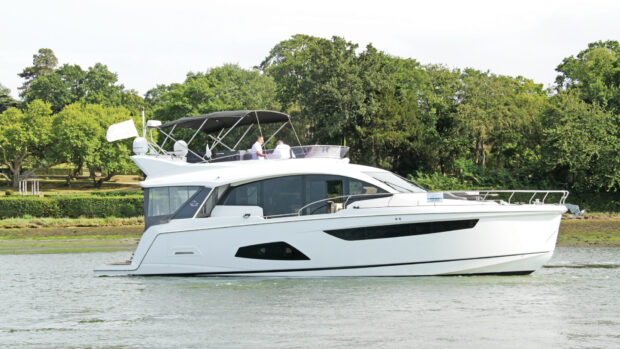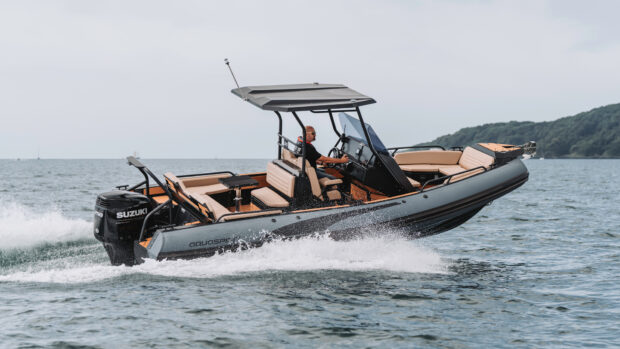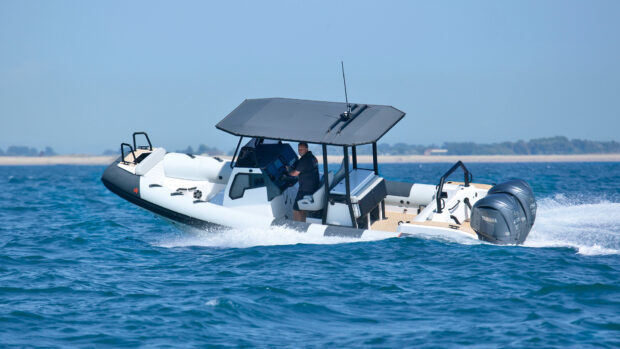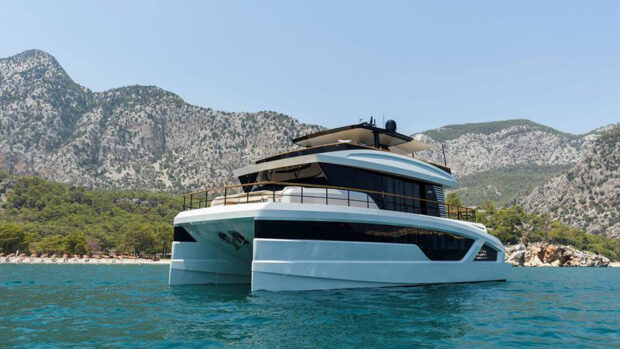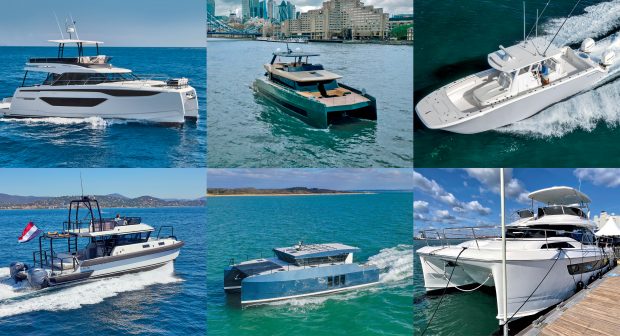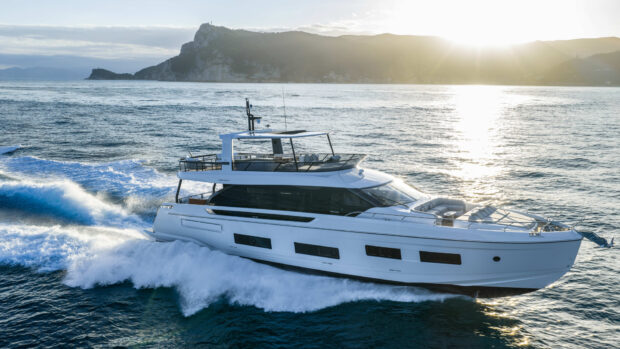If variety is the spice of life, it doesn’t get much spicier than the the Hardy 45 European. Alex Smith puts it though its paces
Keeping your boat life fresh and exciting often involves change. Change of boat, change of guest, change of equipment, change of cruising ground. And heading across the Channel to explore the Continent by means of Europe’s inland waterways is a really superb way to achieve that.
Realistically, of course, a great many inland waterways boats would struggle to cross the Channel and a great many seagoing boats would be utterly impractical (not to mention absurd looking) on canals and rivers. But that’s exactly where Cockwells’ new Hardy 45 European comes in.
Based squarely on customer feedback, this is a boat that enables you to go both inland and offshore with the utmost ease and comfort. Based on the exhaustively proven Hardy 42 offshore hull, it’s basically an ocean-going pilotboat with the air draft and deck arrangement of an inland waterways cruiser – and that, of course, makes it look a shade sedate.
There’s that apparent anathema to modernity, the aft cabin, which seems to have fallen from grace on account of its propensity to elevate the topsides at the back end with blunt vertical mouldings.
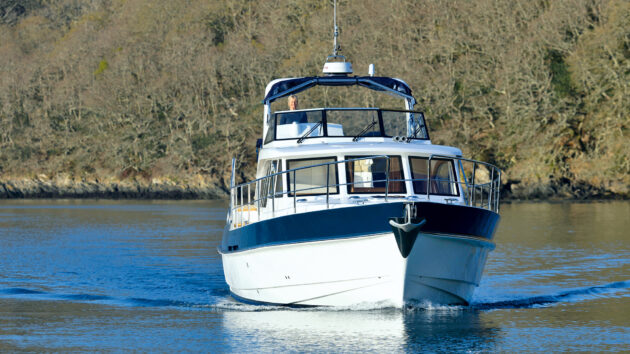
Slow, stable and efficient is no problem for the multi-purpose Hardy
There’s the raised open steering position above and ahead of that, like a compact half-height flybridge that can’t quite escape the stern. And the foredeck also looks rather workmanlike with its confident rejection of sunpads, seats, fridges and tables in favour of a practical open deck littered with robust seamanship hardware.
Right from the start then, you know this is not likely to be a mass-market boat. On the contrary, as a custom-built multi-theatre aft cabin cruiser that combines an inland aesthetic with an offshore pedigree, it’s very much a niche craft. But given how little else you will find along these lines, it feels all the more relevant because of that.
External decks
The raised aft deck comes with a pair of hinged canvases that stretch taut above your head on either side of the folding radar arch. It’s a neatly conceived system and it has to be because on this test boat, there’s no lower helm for you to retreat to if the weather turns.
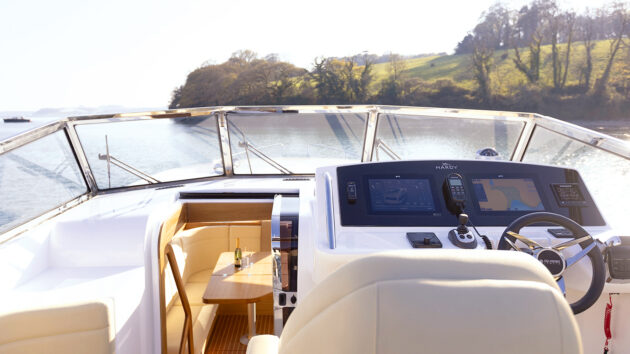
The helm sits a good way aft, on top of the big owner’s cabin
It’s also a sociable helm, as well as a sheltered one, thanks to a neat little companion seat to port and a pair of helm seats at the starboard station that rotate to face the C-shaped dinette that lines the periphery of the space aft.
Step out of here on either side to the symmetrical raised side decks and you get the easiest possible access to the cleats and rails, plus equally easy access to the pontoon thanks to a pair of low-level gates, where the side decks drop down ahead of that aft cabin.
There’s also a neat little tread plate just above the rubbing strake to make the descent that bit easier. It does take a bit more in the way of climbing to reach the swim platform via a pair of steep stairwells on either side of the raised aft deck but that does tend to be the case with aft cabin cruisers and the issue is usefully mitigated with some very substantial rails.
Those rails are even more pronounced at the bow, which is handy because, in the unusual absence of any bow lockers, save for a simple hatch to access the anchor windlass, there’s plenty of space to strap lines and fenders to your rails without them getting in the way.
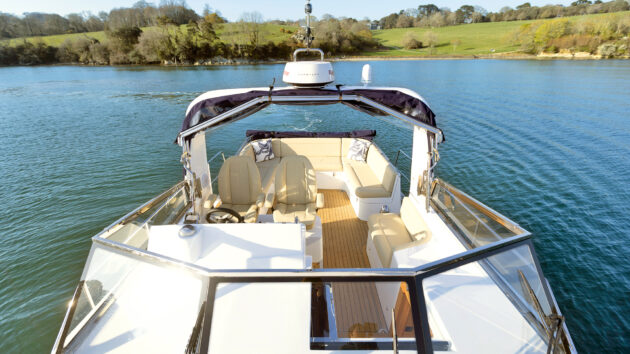
The angular three-part screen is as distinctive as everything else
The bow is a pretty featureless spot in other ways too. Forget seats and cushions and sunbeds and cupholders. This is a place of robust steelwork and practical seamanship devices. But interestingly, only the exterior moulds and the saloon deck are fixed and unchangeable, so you get outstanding customisation potential on this boat.
A set of squishy cushions then, should you want to circumvent the Hardy’s natural role as an old-school adventure boat and turn it into something softer and more mainstream, is very much on the cards.
Saloon and cabins
As you step down into the saloon by means of a stairwell to port of the helm, there’s a delightful wooden rail to guide you down – the type of rail you might be inclined to stop and fondle for a spell. But quality of joinery aside, the first thing that strikes you down here is the sense of space.
In the absence of a lower helm, there’s a large raised dinette to port and a lower, more casual lounge section, further aft and to starboard. That frees up a little space forward for a good sturdy door opening out onto the starboard side deck. It’s a handy feature for getting out onto a pontoon without having to head upstairs and it’s equally handy, should the skipper demand some assistance when you’re down below with a cup of tea.

The low-slung starboard lounge is the more casual of the saloon’s two seating zones
Ahead of this main saloon space, a couple of steps take you down to the starboard galley. It’s a relatively compact space but it’s not quite as hemmed in as you might imagine.
The fact that it remains open to the saloon admits extra light and air so it doesn’t feel at all claustrophobic and the fact that both the fridge and the uncommonly large freezer are tucked across on the port side helps free up the galley itself for extra storage and a double sink.
Across from this section is access to the day heads, which is shared as an ensuite for the guests in the forward VIP cabin. Again, it has quite a modest footprint but headroom is good and the circular shower tray and curved door make great use of the space that is available.
The forward cabin adopts the form of a V berth with a roaming infill. Again, it’s not huge. The beds measure around 6ft in length but there are windows in the raised foredeck moulding for extra light, as well as decent hanging storage and rows of high-level lockers nestling against the hull sides with carpet lining for reduced noise and condensation. As with almost every element of the fit out, the layout and furniture of this cabin can be customised to suit your needs.
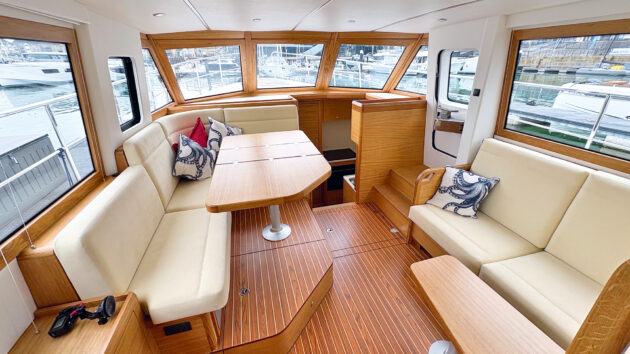
You can spec a lower helm if you like but it’s much better without it
Even so, the aft cabin does feel like a bit of a treat. Accessed by means of a corridor on the port side, with a practical wet locker at its entry point so you can hang up your soggy foulies before you head in, both the scale of the space and its fit-out feel very strong.
The bed sits in the centre, facing forward. It’s flanked on both sides by ranks of handmade cabinetry, at once so large and so thoroughly lovely that it feels almost like a gratuitous calling card from a highly skilled joinery department, keen to show off what it can do.
The dressing table on the starboard side is equally attractive and, while the ensuite heads is similar to the day heads, with its curved oak-faced bulkhead, its larger footprint makes it feel just that little bit more indulgent.
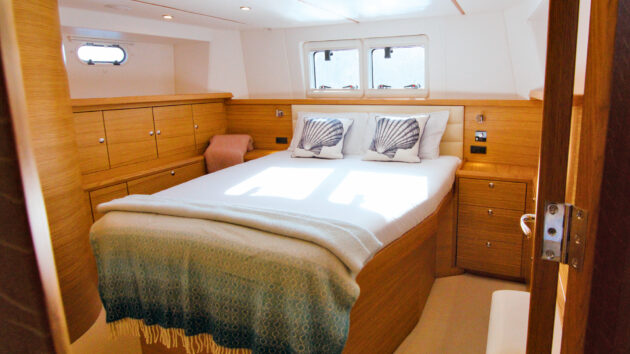
The windows are small but in terms of space and quality, the aft cabin is tough to fault
Solid sea manners
As a rugged oceangoing pilot boat with a semi-displacement hull similar to those used by the RNLI on some of their training craft, it’s perfectly reasonable to expect good things from the Hardy 45 Euro and that’s exactly what you get. In terms of the balance between that fine entry and that prodigious bow flare, it becomes plain when we get underway that softness gets more emphasis here than splash deflection – and in terms of both on board comfort and running efficiency, that’s precisely as you would want it.
That low air draft also does good things for the windage, and the weight distribution feels very strong too. The engines are bang in the centre of the boat and with our 1,650L of fuel distributed between a pair of wing tanks and a nice deep keel tank, it’s a very comfy and dependable boat to helm at sea.
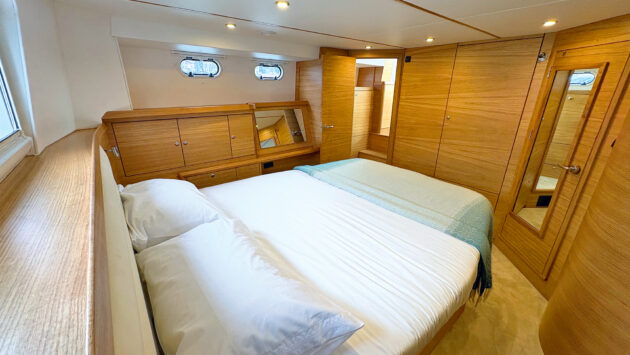
There’s space for an even larger bed in the private aft cabin
Interestingly, though, our test boat has no tabs because the owner of this particular model never saw any merit in them on his previous craft – and in fairness to the Hardy, it does a remarkably good job without them, showing excellent natural trim underway and only moderate lifting of the bow.
Even so, this is a boat that is likely to be used for long passages at relatively moderate speeds so tabs would help refine the angle of attack, maintaining optimum views from the saloon dinette and eking out the best possible efficiency from that excellent hull.
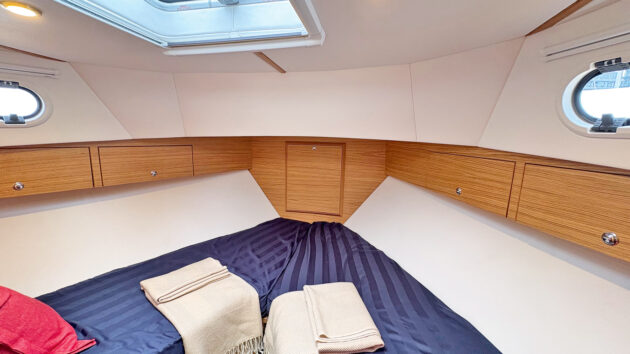
The forward guest cabin uses a V berth with a roaming infill
Even as things stand, though, with a pair of Yanmar 6LY 440hp diesels on straight shafts, we’re seeing a perfectly serviceable fuel flow of 4.4L per mile at 10 knots, increasing to 5.4L at 12 knots and 5.7L at 20 knots for a cruising range of between 230 and 250 miles.
If you know that you’re likely to be spending the bulk of your time inland, you could save money, maintenance and space on a single 440 instead,. In that case you would be reducing your top end from 27 knots to around 16. But either way, there’s nothing at all to worry about here, either in terms of the new Hardy’s build integrity or its seagoing dynamics.
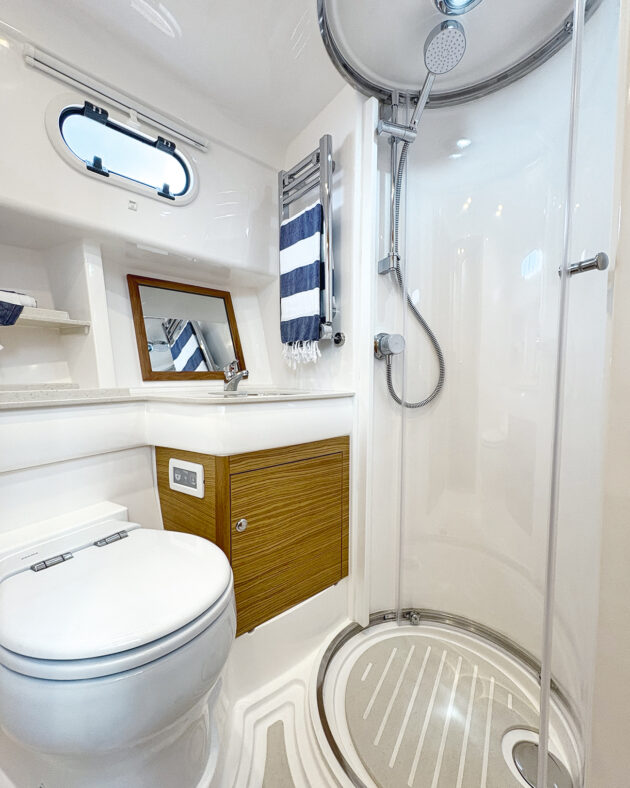
Both bathrooms use cylindrical shower stalls to ease the impact on the other side of the bulkhead
In fact, assuming you equip it with a set of tabs, our only real reservation concerns the skipper’s position. When you’re sitting down at the helm, the screen rim sits bang in line with the horizon, which is a bit aggravating, and your feet dangle in mid air, which is a shade uncomfortable. But if you insist on a decent foot brace and a lift-and-lower mechanism for the helm seat, you’ll be in a very good place indeed.
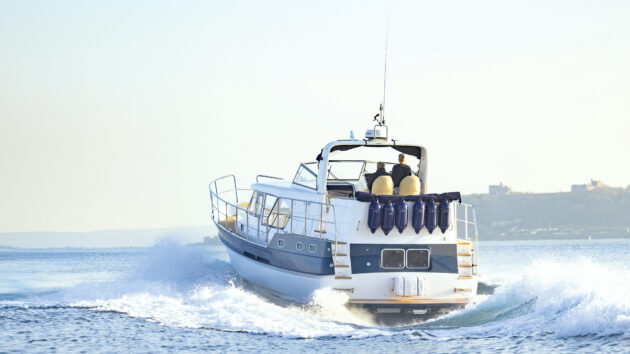
Range is largely unchanged at everything between 12 and 20 knots
Hardy 45 European specifications
LOA: 46ft 7in (14.20m)
Beam: 14ft 5in (4.40m)
Fuel capacity: 1,650 litres
Water capacity: 550 litres
Draft: 3ft 11in (1.20m)
Air draft: 11ft 1in (3.38m)
Displacement: 14 tonnes (light)
Builder: Cockwells
Price from: £1.5M inc VAT
Price as tested: £1.5M inc VAT
Contact: cockwells.co.uk
 If you enjoyed this….
If you enjoyed this….
Motor Boat & Yachting is the world’s leading magazine for Motoryacht enthusiasts. Every month we have inspirational adventures and practical features to help you realise your sailing dreams, as well as tests and news of all the latest motorboats.
Plus you’ll get our quarterly Custom Yachting supplement where we share the last on offer in the superyacht world and at the luxury end of the market.
Build your knowledge with a subscription delivered to your door. See our latest offers and save at least 30% off the cover price.
Note: We may earn a commission when you buy through links on our site, at no extra cost to you. This doesn’t affect our editorial independence.
Verdict
As already mentioned, the Hardy 45 European is not an obvious mass-market boat. It eschews trends with its aft cabin, ignores convention with its featureless foredeck and takes its own direction with a style born primarily out of function. In practical as well as conceptual terms, the fact that it’s built by a small-scale artisan boatyard makes it very much a niche platform. And yet this is a safe and seaworthy boat of a very manageable size with a generous saloon and an excellent owner’s cabin. It’s also a multi-theatre boat, every bit as capable on the inland waterways as it is on exposed sea passages. And the fact that it’s built to spec means that, while it’s pretty much unrestricted in where it can go, it’s all but limitless in how you can refine it to suit your own needs. It’s by no means the cheapest option at this size and as a Cockwells boat, you wouldn’t expect it to be. But if you’re looking for a boat that can bring extra fun and flexibility to your life, and you’re content to be a little different in achieving that, the Hardy 45 Euro is a very appealing proposition.
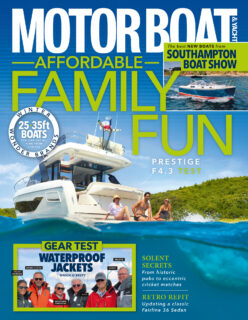


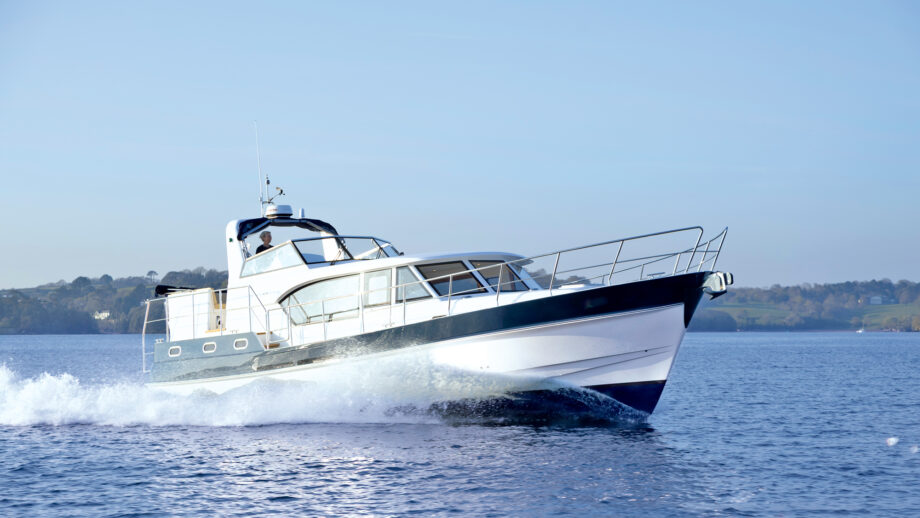
 If you enjoyed this….
If you enjoyed this….